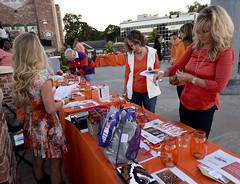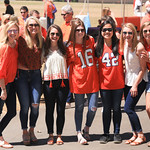Hambrights dedicate time and treasure to teaching leadership skills
When Kate Gasparro ’14 thinks about her success, she goes back to the first conversation she had with fellow alumnus Bob Hambright ’70.
Gasparro was applying for a leadership award that bears Hambright’s name when he impressed upon her the importance of self-examination, a lesson she took to heart. She went on to win the Norris Medal, the highest honor for an undergraduate at Clemson, and is now a Ph.D. student at Stanford University.
“He’s not just a friend,” she said. “He’s a mentor. The Hambrights have been a constant part of my life. I hope as an alumnus, if I can be as successful as Bob and Susan Hambright, I can come back and be as helpful as they are.”
The relationships the Hambrights have formed with Gasparro and other students illustrate how their hands-on approach has already left its mark as they prepare to have an even deeper impact.
The Blowing Rock, North Carolina, couple recently announced a $249,000 Give Day contribution that comes on top of their previous contribution of $251,000. The two contributions together allow Clemson to create the Hambright Distinguished Professorship in Engineering Leadership.
“If we’re going to make the world a better place, the way to do it is to create more and better leaders,” Bob said. “We want to identify kids who have that potential — identify them early on and help them accelerate their development as leaders.”
John DesJardins, a member of the bioengineering faculty, will hold the professorship and continue the work he began with the Hambrights in 2014. Their contribution gives DesJardins an endowed professorship, one of the most esteemed positions on the faculty.
DesJardins thanked the Hambrights and said they are passionate about leadership.
“They are committed to the idea that all Clemson students should have the opportunity to become better leaders during their time at Clemson, and that we have a duty to provide for them the opportunities to grow as leaders in their disciplines,” he said. “Their commitment to this goal is inspiring, and I am honored to be a part of that process.”
DesJardins is charged with creating awareness of leadership’s importance and identifying and accelerating the development of tomorrow’s leaders. He oversees the Robert B. ’70 and Susan B. Hambright Annual Leadership Program in Engineering. Eight engineering students received awards in 2016, and the program goes into its sixth year in the fall. Each student receives $3,000 for leadership-related programs and a $1,000 merit award.
Gasparro, one of the early awardees, used some of her funds to attend a Dale Carnegie program in New York City. She has remained in touch with the Hambrights while working toward her Ph.D. in civil and environmental engineering and a master’s in international policy.
Bob received a mechanical engineering degree from Clemson in 1970 and an MBA from Winthrop University in 1974. One day during his career, it dawned on him it was a good idea to hire people smarter than he was, he said. As a leader, his job was to create an environment where people could work together toward a compelling vision. “If we could tap the collective wisdom of the group, nobody could stop us,” Bob said. “That was just an aha moment for me. From then on, I just wanted to learn as much as I could about leadership.”
Bob retired in 2010 as chief executive officer of the Southeast division of Balfour Beatty Construction Co. The company set up an endowment for the Hambrights focused on creating more and better leaders. “We wanted to be part of the process,” Bob said. “I think that’s the only way you can get the impact you want. It’s been a lot of fun.”
One hiccup in the beginning was that students had trouble spending the money because their schedules were already jam packed. That’s when the Hambrights began working with DesJardins, who helped organize the leadership program and held the forerunner to the endowed professorship, the Hambright Professorship.
Susan Hambright said that DesJardins understands the couple’s vision. “He can see in students that kernel of leadership ability, that light that some kids have, and they just don’t know what to do with it,” she said. “Hopefully, with what we’re doing, he can grow more leaders than before.”

























